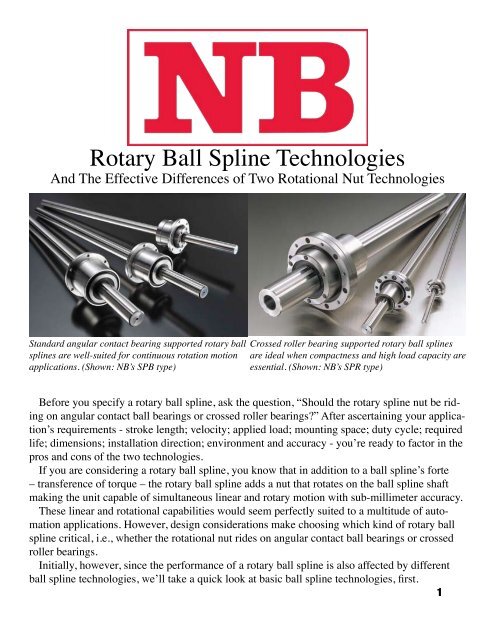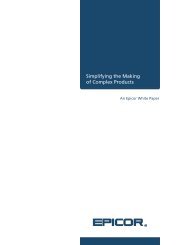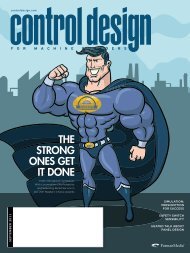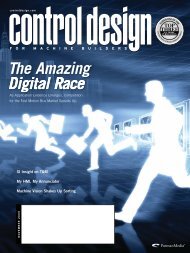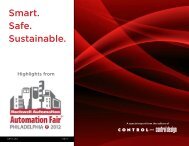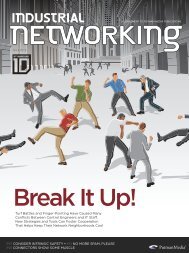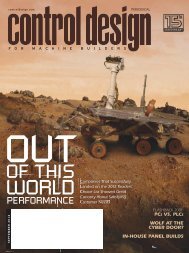Rotary Ball Spline Technologies - NB Linear System
Rotary Ball Spline Technologies - NB Linear System
Rotary Ball Spline Technologies - NB Linear System
- No tags were found...
Create successful ePaper yourself
Turn your PDF publications into a flip-book with our unique Google optimized e-Paper software.
<strong>Rotary</strong> <strong>Ball</strong> <strong>Spline</strong> <strong>Technologies</strong>And The Effective Differences of Two Rotational Nut <strong>Technologies</strong>Standard angular contact bearing supported rotary ballsplines are well-suited for continuous rotation motionapplications. (Shown: <strong>NB</strong>’s SPB type)Crossed roller bearing supported rotary ball splinesare ideal when compactness and high load capacity areessential. (Shown: <strong>NB</strong>’s SPR type)Before you specify a rotary ball spline, ask the question, “Should the rotary spline nut be ridingon angular contact ball bearings or crossed roller bearings?” After ascertaining your application’srequirements - stroke length; velocity; applied load; mounting space; duty cycle; requiredlife; dimensions; installation direction; environment and accuracy - you’re ready to factor in thepros and cons of the two technologies.If you are considering a rotary ball spline, you know that in addition to a ball spline’s forte– transference of torque – the rotary ball spline adds a nut that rotates on the ball spline shaftmaking the unit capable of simultaneous linear and rotary motion with sub-millimeter accuracy.These linear and rotational capabilities would seem perfectly suited to a multitude of automationapplications. However, design considerations make choosing which kind of rotary ballspline critical, i.e., whether the rotational nut rides on angular contact ball bearings or crossedroller bearings.Initially, however, since the performance of a rotary ball spline is also affected by differentball spline technologies, we’ll take a quick look at basic ball spline technologies, first.1
How Basic <strong>Ball</strong> <strong>Spline</strong> <strong>Technologies</strong>Affect Performance<strong>Ball</strong> <strong>Spline</strong> ConstructionA ball spline is constructed with 3 basic components: a grooved shaft, a spline nut, and ballbearings. Unlike ball bushings, the ball spline nut rides on a grooved shaft, which prevents thenut from rotating on the shaft. This allows transfer of torque through a shaft to a nut or viseversa. However, a typical application requires the shaft or the nut to be mounted to a fixedstructure. When the shaft needs to be fixed, ends of the shaft can be turned down to accommodatethe mounting of radial bearings which will support rotation, however when the nut needsto be fixed, the radial bearing must be mounted on the outer diameter of the nut which can makeoverall assembly bulky and the nut is not as easily modified to accommodate various bearingsizes.This is where the rotary ball spline becomes efficient and economical. Because the rotary ballspline already has a radial support bearing built into the ball spline nut, there is no need for auser to find, source, and integrate one. Moreover, the overall dimension of the rotary ball splinenut is much more compact than a standard ball spline nut with an added radial support bearing.<strong>NB</strong>’s SPB standard angular contact bearing supported rotary ball spline showing ball elementsin the rotary nut. 2
<strong>Spline</strong> shafts vary as to whether they are precision-ground, ground or drawn steel bar. Theyalso vary as to the grade of the base material. Manufacturers rank shafts by characteristics suchas the tolerance of ground shafts, perpendicularity to the end face, concentricity of the partmountingsection in relation to the support section, as well as the material grade.Controlling machining of all the shaft grooves so they are linear all the way through in highaccuracies is very difficult. Non-ground (drawn) spline shafts are, naturally, of lower accuracy.Generally, manufacturers present 3 accuracy ratings, Precision (meaning their highest precision),High (meaning their standard grade – usually a stock item) and Normal or Commercial(often a non-ground shaft). However, one manufacturer’s top grade can be another’s standardgrade. Comparing accuracy grades comes down to comparing measures of the above-mentionedranking characteristics – shaft diameter tolerance, straightness, perpendicularity and concentricity.If a lesser degree of accuracy is acceptable because the primary concern is torque transfer, lineartransfer, rotational motion or length, then drawn, non-ground spline shafts may be the bestchoice. Some drawn shafts can use the same nuts as ground spline, but load capacity is reducedbecause the nut is traveling in a non-ground raceway groove. However, they are less expensiveand can be as long as five meters, making them appropriate for material transfer and handlingapplications.How The Two <strong>Rotary</strong> <strong>Ball</strong> <strong>Spline</strong> <strong>Technologies</strong> Affect PerformanceWhat Is A ‘Crossed Roller Bearing’ <strong>Rotary</strong> <strong>Spline</strong> Nut?Crossed roller bearings work similarly to ball bearings, except that the bearings housed withinthe rotary nut are cylinder-shaped instead of ball shaped. The rollers crisscross each other at a90° angle and move between “V” grooved bearing ways or grooves ground into the spline nutouter diameter and rotary flange attached on the nut.Crossed roller bearings offer a line of contact versus a ball bearing’s points of contact, therebycreating a broader contact surface that can carry a heavier load. This provides more rigidity, lessdeformation and thus more accuracy compared to the point contact of balls. Because of this,crossed-roller bearings are the most accurate form of mechanical motion component.4
As rotary support bearings, both angular contact bearings, which ride on balls, and crossedroller bearings can support both axial load and radial load as both types of loading or combinedloading can be expected depending on ball spline applications. An angular contact bearingachieves this with two rows of balls whereas a crossed roller bearing can do this in a single row,but with some disadvantages such as speed and wear issue as described below.DimensionsWhen comparing dimensions, one is immediately struck by the difference in size between a<strong>Rotary</strong> <strong>Ball</strong> <strong>Spline</strong> whose rotary support bearing rides on crossed roller bearings as opposed toan RBS whose rotary support bearing rides on ball bearings, i.e. an angular contact bearing. Onthe spline shaft, the spline nuts are basically the same. In each case, they ride on ball bearings.The RBS whose rotary support bearing rides on crossed roller bearings is much more compact.The reason the crossed roller bearing supported rotary ball spline takes up so much less spaceis that the rotary nut and spline nut is one unit. The crossed rollers are directly attached to thespline nut’s outer cylinder. In addition, the crossed roller rotary support bearing is thinner.CompactnessThe crossed roller type is compact. It has a relatively high load capacity in terms of the sizeof the crossed roller section. It’s ideal when you need to keep something compact and supporta high load for an application that doesn’t require continuous rotation. Since an angular contacttype is larger, the rotational section is larger, with the overall spline dimensions being largerthan the crossed roller type. Its large footprint reduces the compactness of the overall application.Accuracy and DeflectionCrossed rollers provide a larger contact area than ball bearings, reducing elastic deformation.Because of this greater stiffness, crossed rollers provide consistently precise movement. Thereis a direct correlation between the contact area of the crossed rollers and load capacity. Loadcapacity can be increased greatly by roller-to-raceway contact. <strong>Ball</strong>s, typically, make contact attwo to four points.EnduranceHowever, for applications that continuously rotate, crossed rollers wear out more quickly thanball bearings because more of their contact area is in use. For example, an angular contact typeis a better choice for driving the spindle drive shaft of a grinding machine, a conveyor belt ora wire winder. Whereas, crossed rollers are highly desirable when the attached gripper rotatesback and forth, such as moving a half or quarter rotation when changing the angle of an item.Rotational SpeedIn a rotational speed comparison, the angular contact type is more advantageous than thecrossed roller type. Comparing the two types at a standard 16mm (the diameter of the spline)size, the crossed roller type nut is capabile of 1,080 rpm versus the maximum rotational speedfor an angular contact type nut, which is 4,000 rpm.5
RetrofittingSince crossed roller rotary nut technology is newer, most existing applications already use theangular contact bearing supported ball spline. That makes changing to the newer technology expensivesince it’s not the same size – it’s more compact. However, most angular contact bearingsupported ball splines are interchangeable, size-wise. Though outer dimensions of interchangeablerotary ball splines may be the same, there are design advantages to consider such as thenumber of grooves on the spline, the points of ball contact within the grooves and shaft rigidity.Now, the choice is up to you.Naoki YamaguchiAssistant Technical Manager, naoki@nbcorporation.com<strong>NB</strong> Corporation of America930 Muirfield Drive, Hanover Park, IL 601331-800-521-2045, Fax: (630) 295-8881http://www.nbcorporation.comCrossed roller bearing supported rotary ball spline oriented vertically in SCARA robot type ‘Pick and Place’application. Gripper is at the end of an extended arm so the spline shaft can rotate the gripper in a large circularmotion. The ball screw moves the spline shaft up and down. 6


